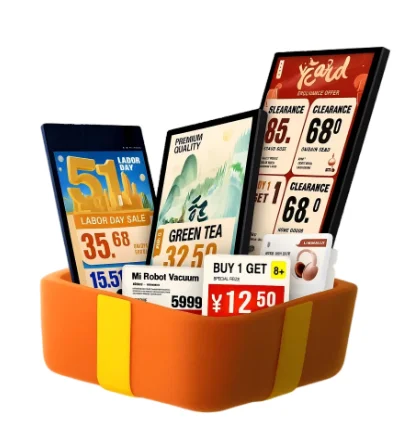The Bluetooth Special Interest Group recently released the Bluetooth Core Specification 5.4, a new wireless standard for Electronic Shelf Labels that breaks down the technical barriers of proprietary communication protocols among manufacturers, enhancing system compatibility between different vendors and further reducing costs Baidu BaikeIot101. Market research firm ePaper Insight predicts that the global ESL module market will grow to approximately $3 billion in 2025 Iot101.
Electronic Shelf Labels are electronic display devices that can replace traditional paper price tags, connected to store computer databases through networks to display the latest product prices and information in real-time Baidu Baike. This technology utilizes low-power e-ink display technology with a single-use lifecycle of 5-7 years, improving price change efficiency to the minute level with an error rate below 0.00001% Baidu Baike. Compared to the tedious manual process of replacing traditional price tags, which takes at least two minutes per tag, ESL systems can complete price changes for tens of thousands of tags in a very short time.
The automation trend in the retail industry is a key factor driving the growth of the electronic shelf label market, as retailers increasingly prefer to adopt ESL systems to improve operational efficiency and customer satisfaction Globalmarketmonitor. Through direct connection with Enterprise Resource Planning and Point of Sale systems, ESL not only reduces manual operation errors but also enables dynamic pricing and real-time product location management. Data shows that using ESL can increase product shelving speed by 50%, improve price tag refresh efficiency by 85%, and reduce overall costs by 70% Ylwlesl.
Major electronic price tag system solution providers currently include France’s SES, China’s Hanshow, Sweden’s Pricer, and South Korea’s Solum Jishulink. In the Chinese market, ZKONG, Clouder, Wollian Electronics, and more than ten other companies are actively expanding their market share. Overseas retailers such as Metro, Carrefour, 7-11, and Walmart have widely adopted ESL, while Chinese retailers like Wumart and Yonghui have also implemented practical applications Baidu Baike.
On the technology innovation front, E Ink has partnered with multiple semiconductor companies to develop System on Panel chip technology, creating next-generation ESL solutions that use fewer materials, consume less power, and have simpler manufacturing processes EET China. These technological advances not only enhance product performance but also align with environmental requirements under the dual carbon strategy.
With the advancement of Bluetooth standardization and continuous technological innovation, Electronic Shelf Labels are expanding from high-end supermarkets to more retail formats, becoming important infrastructure for the digital transformation of physical stores.
Hydraulic Spare Parts
Hydraulic Spare Parts Market Flourishes, Exceeding $29.8 Billion in 2025 with Intelligent Transformation as Mainstream Trend
The global hydraulic spare parts market was valued at $29.855 billion in 2025, accounting for 57.9% of the global hydraulic equipment market, and is projected to grow to $42.012 billion by 2034 with a compound annual growth rate of 3.86% Industryresearch. This robust growth momentum reflects the strong demand for hydraulic system spare parts driven by continued advancement in industrial automation, infrastructure construction, and agricultural mechanization.
In terms of market drivers, the construction machinery aftermarket services market is experiencing robust growth, with hydraulic systems including cylinders, pumps, and valves as core components GlobeNewswire. Hydraulic components for construction machinery such as excavators are experiencing significant technological advancements, with 3D printing technology revolutionizing the spare parts market by enabling rapid production of customized gears and specific hydraulic components, significantly reducing lead times and costs Made-in-China.com.
Technological innovation is reshaping the industry landscape. The adoption of electro-hydraulic systems has become a significant trend, with the integration of electronics and hydraulics enabling precise control and energy efficiency improvements, while IoT technology application in hydraulic systems makes remote monitoring, predictive maintenance, and data-driven insights possible MarkWide Research. Manufacturers are actively promoting the digitization of hydraulic products through electro-hydraulics modules featuring digital interfaces and sensor intelligence, enabling intelligent design capabilities, enhanced configurability, and precision control systems Mordor Intelligence.
Regarding industry leader activities, CNH introduced its FLEETPRO aftermarket line-up at Agritechnica 2025, including a portfolio of certified spare parts and consumables for agricultural equipment, with precision farming kits available with both hydraulic and assisted steering options compatible with all brands and models GlobeNewswireMarketScreener. Continental added over 1,000 new wheel bearing kits, chassis and steering components in 2025, planning to continue expanding its portfolio in 2026 Continental.

Sustainability has become an important trend. Market demand for eco-friendly spare parts made from recyclable materials is rising, driven by regulatory compliance requirements, with projections that by 2030, 65% of spare parts will be produced via 3D printing or recycled materials Accio. Manufacturers are developing more environmentally friendly spare parts, emphasizing biodegradable materials and improved energy efficiency, paving the way for sustainable development in construction machinery Made-in-China.com.
Regarding regional markets, the Asia-Pacific region accounts for 28.75% of market share in 2025, with China at 28.10%, India at 14.35%, and Japan at 14.85% Industryresearch. As industrialization accelerates in emerging economies and infrastructure investment increases, the region is expected to maintain the highest growth rate.
Looking ahead, e-commerce platforms will grow at a 12% CAGR, with the implementation of on-site 3D metal printing capabilities enabling rapid production of critical spare parts and reducing inventory overhead AccioGlobeNewswire, as the hydraulic spare parts market moves toward a more intelligent, environmentally friendly, and efficient future.
Keep exploring — discover more insights waiting just a click away at Management Works Media.






